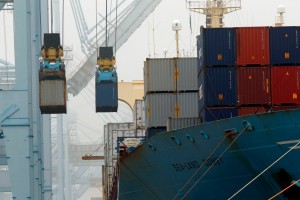By Jeff Horseman
jhorseman@scng.com
A regional air quality board on Friday approved a landmark rule that would require warehouses and, by extension, the diesel-fueled trucks serving them, to cut chronic air pollution linked to asthma, cancer and deaths in Southern California.
In a 9-4 vote after hours of comments and discussion, the South Coast Air Quality Management District board passed the Warehouse Indirect Source Rule, described as a milestone in the fight for clean air and supported by environmentalists, public health and social justice advocates. Business interests opposed the rule, warning it could cost jobs and harm a growing segment of the local economy that sends goods throughout the United States.
Voting in favor were William Burke; Los Angeles City Councilman Joe Busciano; South Pasadena City Councilman Michael Cacciotti; Gideon Kracov; Los Angeles County Supervisor Sheila Kuehl; Riverside County Supervisor V. Manuel Perez; Long Beach City Councilman Rex Richardson; Wildomar City Councilman Ben Benoit and former Democratic state Sen. Vanessa Delgado.
Voting no were San Bernardino County Supervisor Janice Rutherford; Orange County Supervisor Lisa Bartlett; Highland City Councilman Larry McCallon and Yorba Linda City Councilman Carlos Rodriguez.
The South Coast district is responsible for improving air quality for more than 17 million people in Los Angeles, Orange, Riverside and San Bernardino counties. Its 13-member board includes county supervisors and city council members from the region.
Following a presentation on the rule, Kuehl said the sanctions the region would face by not complying with federal air standards are more painful than the costs associated with the rule.
“We’re weighing lives and health” against record profits enjoyed by the logistics industry, she said. “(The rule is) going to make an enormous difference in people’s lives.”
Richardson called the rule “one of the most meaningful and consequential steps in addressing air pollution in decades.”
“Economic recovery is not good enough if it’s not inclusive (and) clean,” he said. “We have a responsibility to commit to a clean and modern goods movement system.” Rutherford said that, while there’s “no question” the region needs to do more to improve air quality, she questioned whether the rule was the best way to do it.
“We all very much hope that truck fleets turn over (to zero-emission technology) as quickly as possible,” she said. “I just don’t believe this rule gets us there.”
Bartlett said the California Air Resources Board is the “primary regulatory authority” over trucks and the warehouses will pass along the rule’s costs to consumers.
“If we end up long term with empty warehouses” because warehouses go to states with less burdensome regulations, “we lose out on a lot of things,” Bartlett added.
Kuehl countered that people concerned about air quality “are not concerned about the cost of their cereal. They’re concerned about their lungs.”
More than 140 people signed up to speak on the rule. Most, including San Bernardino City Councilman Ben Reynoso, urged the board to pass it.
“The reality is without this rule being implemented, nothing is going to change,” he said. “It doesn’t matter what the economic benefits are if no one’s around to spend it.”
Ana Gonzalez of the Riverside County-based Center for Community Action and Environmental Justice said her son has developed asthma that his doctor blames on pollution from diesel exhaust.
“Make a difference in my community … my son cannot play baseball because of his condition,” she said. “Please, please pass this (rule) today.”
Business alliances were among those opposed, saying the rule would kill jobs while doing little to address air pollution.
“Imposing a rule that will cost hundreds of millions of dollars (and) is not likely in the board’s jurisdiction … is simply bad policy,” said Sarah Wiltfong of the Los Angeles County Business Federation.
Paul Granillo, president and CEO of the Inland Empire Economic Partnership, said people of color will be especially hard hit with job losses stemming from the rule.
“As we emerge from the (coronavirus) pandemic, the last thing regulators should be doing is threatening jobs,” he said.
The Inland Empire and Los Angeles County are among the nation’s worst regions for air quality, with much of the pollution blamed on diesel trucks delivering goods from the ports of Los Angeles and Long Beach into a burgeoning landscape of mega-warehouses that employ thousands. Diesel exhaust can aggravate allergies and lead to breathing problems, heart problems and cancer, according to the California Office of Environmental Health Hazard Assessment. Nitrogen oxide from diesel fumes combines with other air pollutants to form ozone, a key contributor to smog.
Neighborhoods near warehouses “face substantially higher burdens” than other neighborhoods, including higher rates of asthma and heart attacks, a district report on the rule states. Communities next to warehouses tend to have higher poverty rates and more African Americans and Hispanics living in them, according to the report.
The rule, which seeks to comply with 2023 and 2031 federal deadlines for reducing ozone that carry sanctions if they’re not met, applies to warehouses greater than 100,000 square feet. It sets up a system in which warehouses choose from a menu of options — installing rooftop solar panels and using zero-emission or near-zero emission trucks, for example — to score a required number of points.
Warehouses also could pay a mitigation fee funding air-quality improvement efforts in communities near warehouses. The rule, which is expected to affect about 3,000 warehouses, will be phased in over a three-year period.
The district’s staff estimates the rule will cut nitrogen oxide emissions by 1 ½ to 3 tons a day, or 10% to 15% by 2031. Between 2022 and 2031, the rule could lead to 150 to 300 fewer deaths, 2,500 to 5,800 fewer asthma attacks, and 9,000 to 20,000 fewer work loss days and public health benefits worth $1.2 billion to $2.7 billion, the report found.
The logistics industry, which provides thousands of jobs in the ports and Inland warehouses, has pushed back against the rule, saying it’s too costly and will lead to higher prices for consumers. Industry representatives have argued that the district lacks the authority to implement the rule, which they contend amounts to an illegal tax. Warehouses also don’t often own the trucks coming to them, rule critics said.
The staff report found implementation costs could be as high as $979 million and that 11,100 jobs from 2022 to 2031 potentially won’t be created as warehouses switch to cleanemission technologies.
District staff, who say the board can legally enact the rule, addressed the concern that there’s not enough electric trucks available to help warehouses comply. The rule’s phase-in period corresponds with the expectation that more electric trucks will hit the market, and there are other ways warehouses can cut emissions, staff wrote in their analysis.

Big rigs clog the intersection of Van Buren Boulevard and Etiwanda Avenue in Jurupa Valley in 2015. The South Coast Air Quality Management District board voted 9-4 to require warehouses — and the trucks that serve them — to cut emissions.
KURT MILLER — STAFF PHOTOGRAPHER

In this screen grab, members of the South Coast Air Quality Management District board meet in an online meeting via Zoom on Friday.
VIA ZOOM

